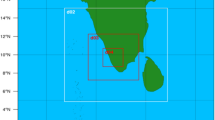Abstract
In this study, an attempt has been made to bring out the observational aspects of vertical wind shear in thunderstorms over Minicoy. Case studies of thunderstorm events have been examined to find out the effect of vertical wind shear and instability on strength and longevity of thunderstorms. Role of vertical wind shear in thunderstorms and its mechanism has been explored in this study. Results reveal that for prolonged thunderstorms high and low instability along with moderate to high vertical wind shear (moderate: 0.003 S−1 ≤ vertical wind shear ≤ 0.005 S−1 and high: > 0.005 S−1) play a significant role in longevity and strength of thunderstorms. The mechanism of vertical wind shear in thunderstorms was investigated in a few cases of thunderstorm events where the duration of thunderstorm was covered by the radiosonde/rawin ascent observation taken at Minicoy. Empirical model has been developed to classify thunderstorm type and to determine the strength and longevity of thunderstorms. Model validation has been carried out for selected cases. Model could classify thunderstorm type for most of the cases of thunderstorm events over island and coastal stations.
Similar content being viewed by others
References
Basu G C and Mondal D K 2002 A forecasting aspect of thundersquall over Calcutta and its parameterization during pre-monsoon season; Mausam 53 271–280.
Browning K A and Ludlam F H 1962 Airflow in convective storms; Quart. J. Roy. Meteor. Soc. 88 117–135.
Browning K A 1977 The structure and mechanism of hailstorms; Hail: A Review of Hail Science and Hail Suppression; Meteor. Monogr.; American Meteorological Society 16 1–43.
Browning K A 1986 General circulation of middlelatitude thunderstorms; In: Thunderstorm morphology and dynamics; (ed.) Kessler E; Univ. Oklahoma Press, Norman, OK, 133–152.
Byers H R and Braham R R 1949 The thunderstorms, U.S. Govt. Printing Office, Washington D.C., USA, 287 pp.
De U S and Dutta S 2005 West coast rainfall and convective instability; J. Indian Geophysics Union 9 71–82.
Galway J G 1956 The lifted index as a predictor of latent instability; Bull. Amer. Meteor. Soc. 37 528–529.
Gilmore S M and Wicker J L 1998 The influence of midtropospheric dryness on supercell morphology and evolution; Mon. Wea. Rev. 126 943–958.
Kandalgaonkar S S, Tinmaker M I R, Kulkarni M K and Nath A 2002 Thunderstorm activity and sea surface temperature over the island stations and along east and west coast of India; Mausam 53 245–248.
Klemp J B 1987 Dynamics of tornadic thunderstorms; Ann. Rev. Fluid Mech. 19 369–402.
Manohar G K and Kesarkar A P 2003 Climatology of thunderstorm activity over Indian region: A study of eastwest contrast; Mausam 54 819–828.
Moncrieff M W and Miller M J 1976 The dynamics and simulation of tropical cumulus and squall lines; Quart. J. Roy. Meteor. Soc. 102 373–394.
Mukherjee A K, Korkhao J M and Srinivasan V 1961 On some sea surface characteristics in relation to storm development over Arabian Sea; Indian J. Meteorol. Geophys. 12 598.
Mukherjee A K, Sen P N and Chakrabarty K K 1983 Dependence of diurnal variation of thunderstorm on physical features; Vayu Mandal 13 105.
Ranalkar M R and Chaudhari H S 2009 Seasonal variation of lightning activity over the Indian subcontinent; Meteorol. Atmos. Phys. 104 125–134.
Rao D V and Mukherjee A K 1958 On forecasting hailstorms by method of vertical wind changes; Indian J. Meteorol. Geophys. 9 313–322.
Rasmussen E N and Wilhelmson R B 1983 Relationship between storm characteristics and 12 GMT hodographs, low level shear and stability, Preprints, 13th Conf. on Severe Local Storms, Tulsa, OK American Meteorological Society, 55–58.
Ray Choudhary S N, Subramanian Y H and Chellappa R 1959 A climatological study of storms and depressions in the Arabian Sea; Indian J. Meteorol. Geophys. 10 283.
Schneider D and Sharp S 2007 Radar signatures of tropical cyclone tornadoes in central north Carolina; Wea. Forecasting 22 278–286.
Sen P N 2005 Thermodynamics of the atmosphere; Lecture notes of the second SERC school on aviation meteorology, AFAC, Coimbatore, India.
Srivastava A K and Sinha Ray K C 1999 Role of CAPE and CINE in modulating the convective activities during April over India; Mausam 50 257–262.
Weisman M L and Klemp J B 1982 The dependence of numerically-simulated convective storms on vertical wind shear and buoyancy; Mon. Wea. Rev. 110 504–520.
Wibmeier U and Goler R 2007 The influence of vertical wind shear on deep convection in the tropics; Fourth European Conference on Severe Storms, Trieste-Italy.
Williams E and Renno N 1993 An analysis of the conditional instability of the Tropical atmosphere; Mon. Wea. Rev. 121 21–36.
Author information
Authors and Affiliations
Corresponding author
Rights and permissions
About this article
Cite this article
Chaudhari, H.S., Sawaisarje, G.K., Ranalkar, M.R. et al. Thunderstorms over a tropical Indian station, Minicoy: Role of vertical wind shear. J Earth Syst Sci 119, 603–615 (2010). https://doi.org/10.1007/s12040-010-0044-3
Received:
Revised:
Accepted:
Published:
Issue Date:
DOI: https://doi.org/10.1007/s12040-010-0044-3




